




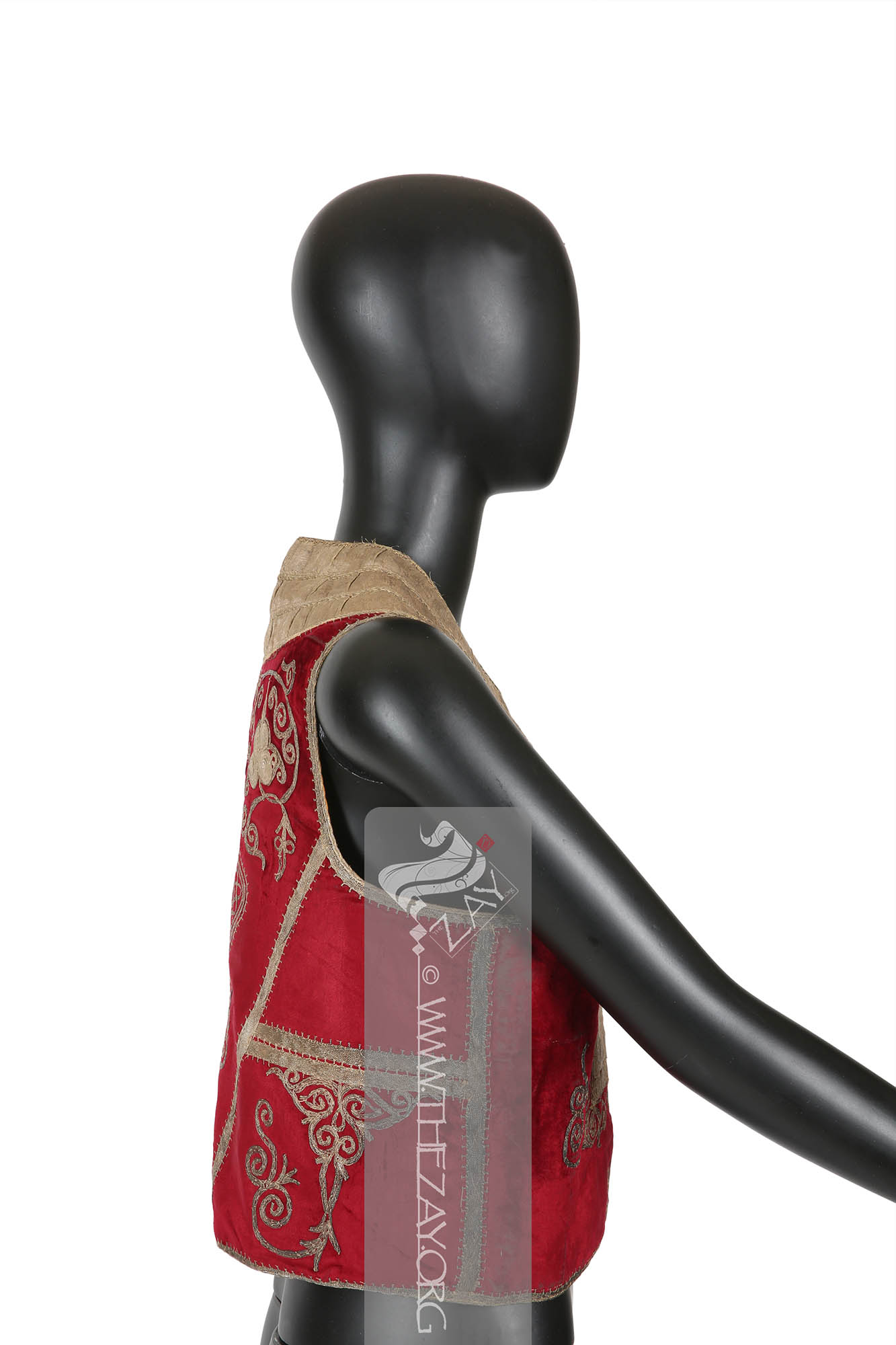
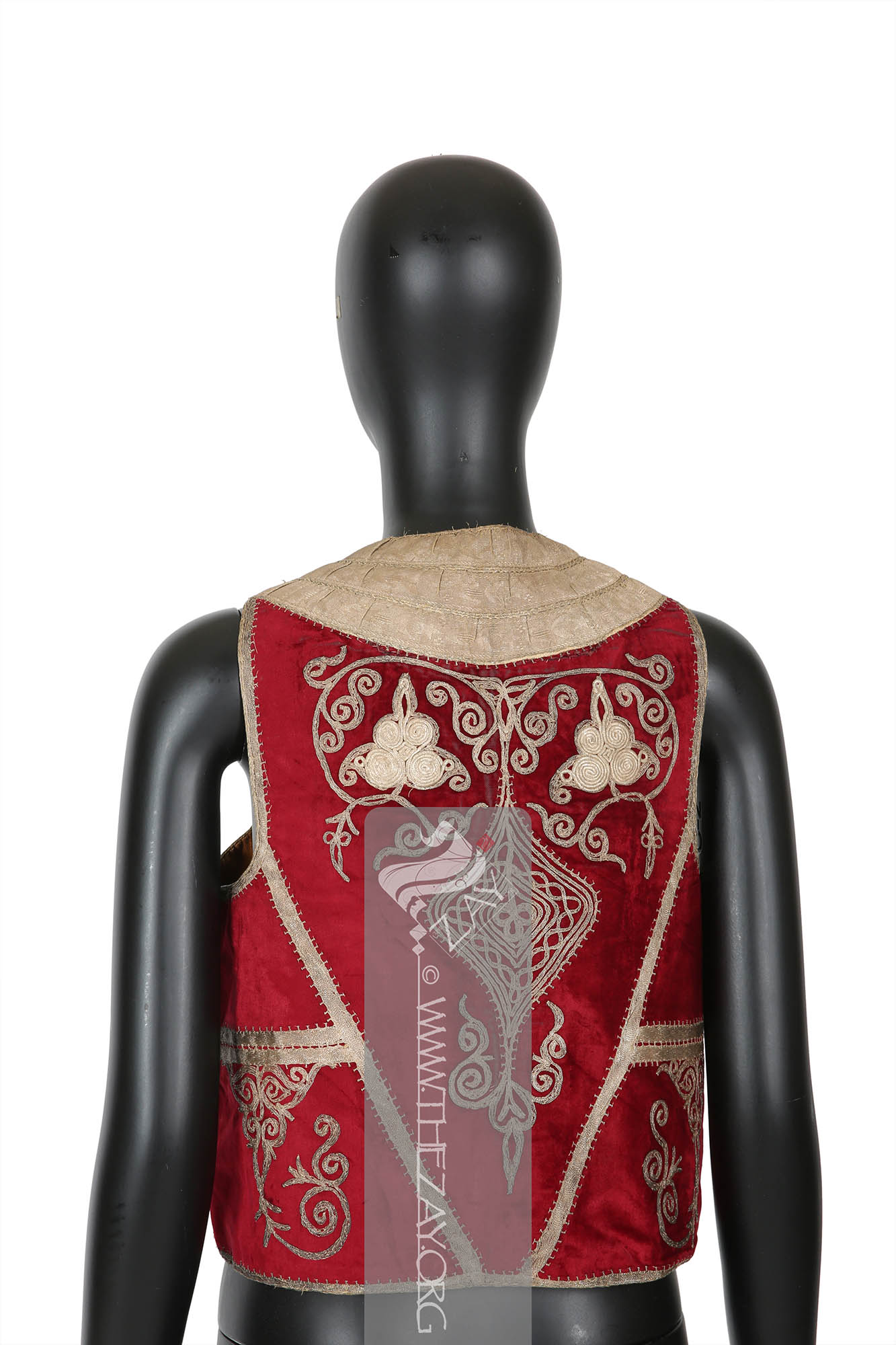
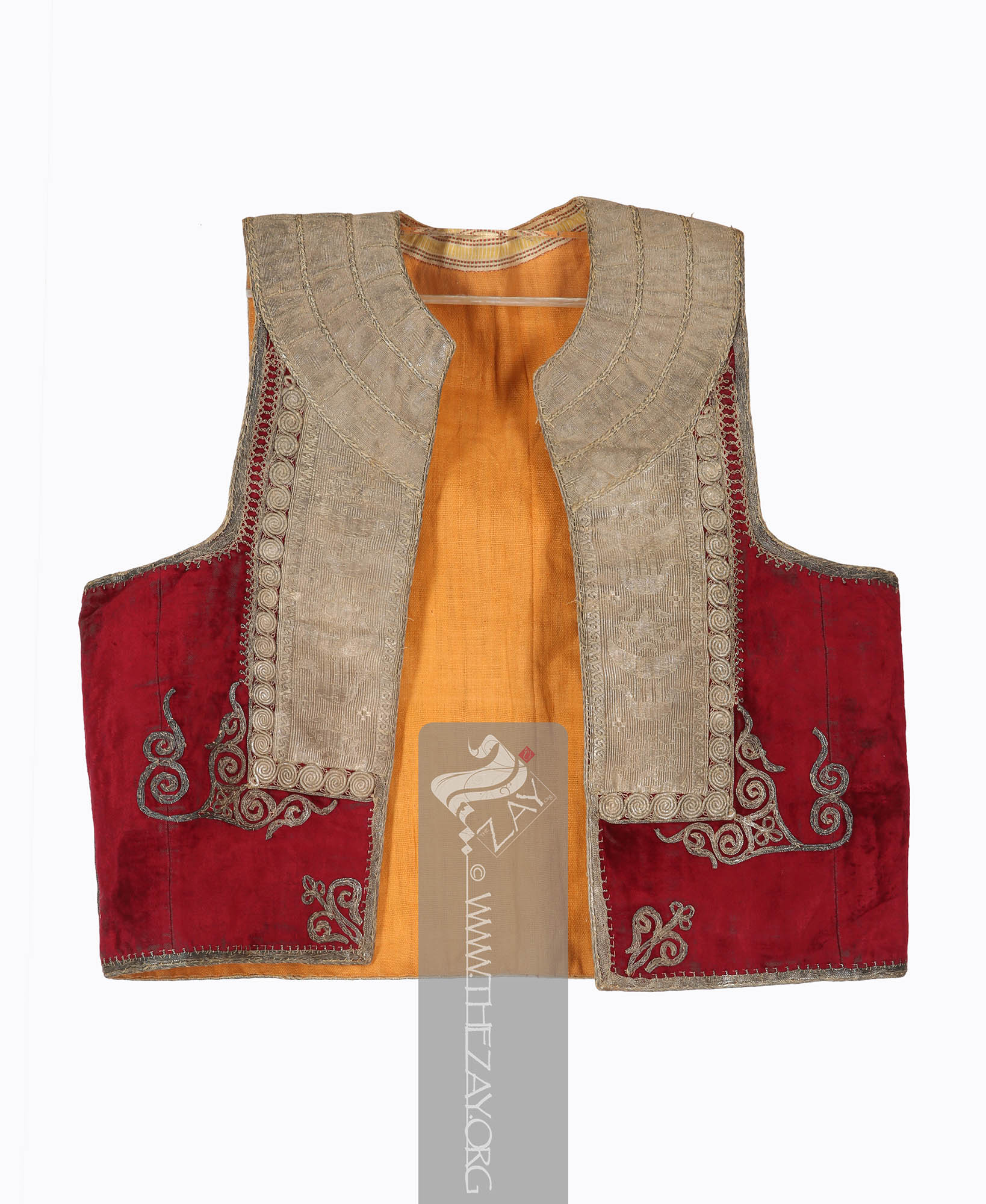
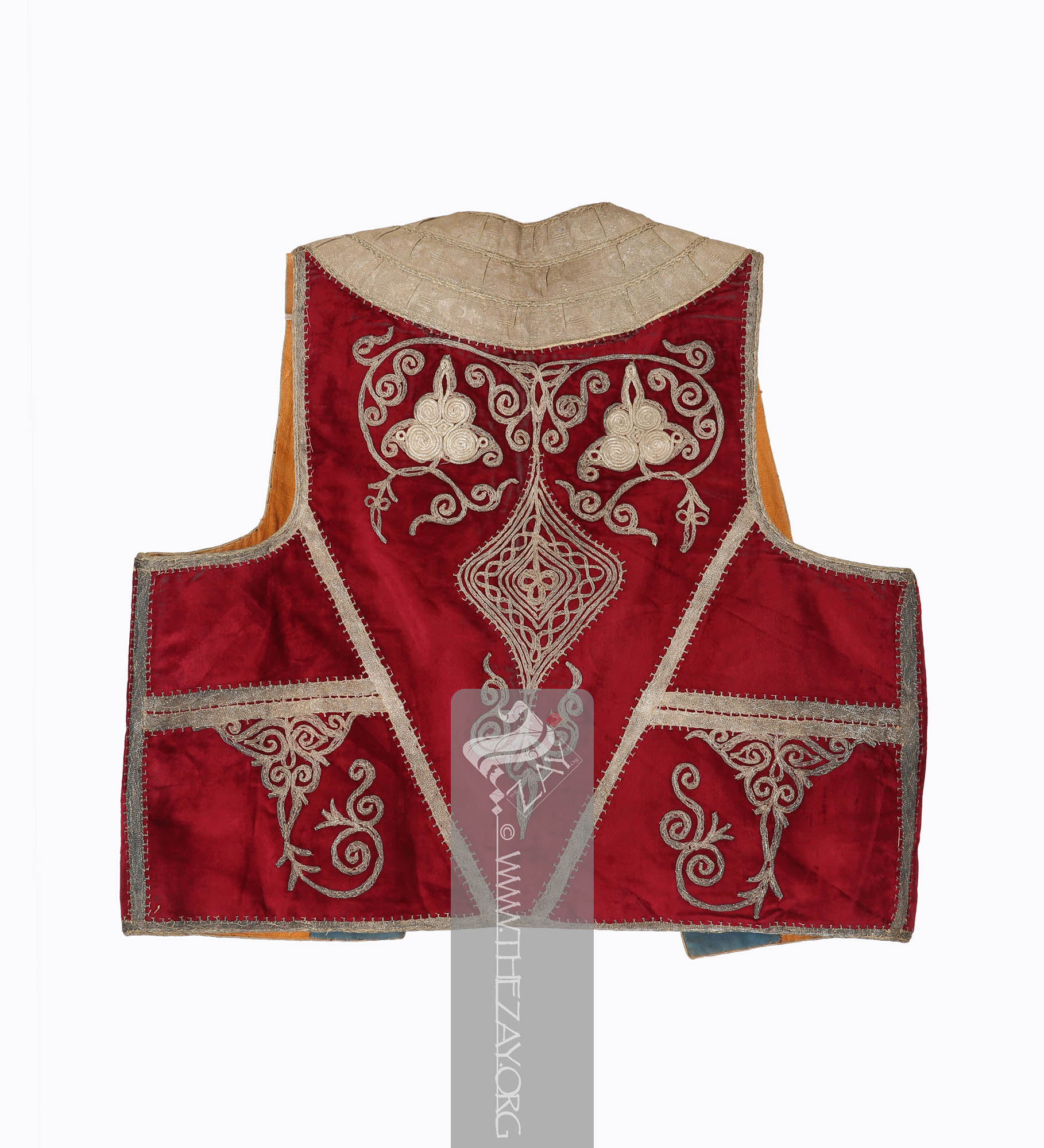
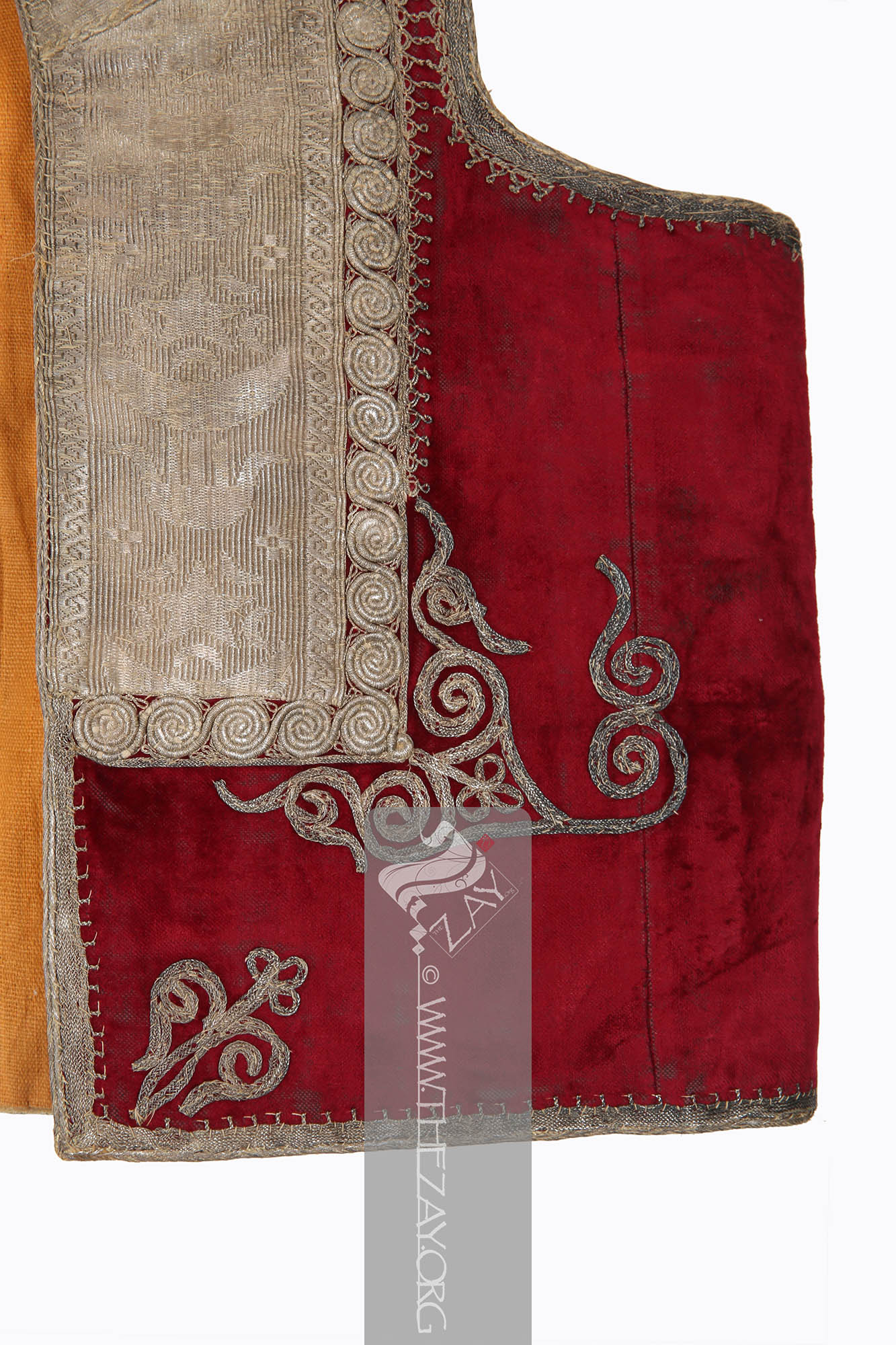
| Local Name | Farmlah |
| Object Category | Overgarment |
| Gender | Female |
| Date of object | c. 19th-20th century |
| Place Of orgin | Libya |
| Region | Libya |
| Object Range | Libya, Algeria, Egypt, Italy, Greece, et al |
| Dimensions | Length: 49 cm Width: 34 cm |
| Materials | Metal Silk Cotton |
| Technique | Hand Embroidered Hand Stitched Woven Other |
| Color | |
| Motif | Floral Geometric Arabesque Paisley |
| Provenance | Purchased, dealer, London 2021 |
| Location | The Zay Zay: (Arabic: costume, Pl. azyaā’), a set of clothes in a style typical of a particular country or historical period. Initiative |
| Status | In Storage |
| ZI number | ZI2021.500880.3 LIBYA |
Object Note
Part of a lot with three other objects also in the collection (ZI2021.500880.1 MOROCCO, ZI2021.500880.2 MOROCCO, ZI2021.500880.4 TUNISIA).
Object History
This object was purchased by Dr. Reem Tariq
Ṭariq: (Arabic; Synonym: tulle_bi_talli; talli; badla; khus_dozi ), series of small metal knots made on a woven net ground as embellishment. The term is commonly used in the Levant Arab region specifically in Lebanon. Ṭariq: (Arabic; Synonym: tulle_bi_talli; talli; badla; khus_dozi ), series of small metal knots made on a woven net ground as embellishment. The term is commonly used in the Levant Arab region specifically in Lebanon.
Object Features
This is a red silk velvet ceremonial waistcoat (farmlah
Farmlah: (Arabic), a traditional ceremonial sleeveless vest worn by both men and women, especially of the Berber community of the North African countries. The garment is opulently embellished over a velvet base with gold and silver threads for women while the male counterparts are considerably simpler.
The field is embellished mostly with metal threads possibly in silver embellished on the (crimson
Crimson: (Persian/Arabic and Turkish: qirmiz or kirmiz – red), is a vivid red color originally made from the dried bodies of a scale insect of the Kermes genus native to the Mediterranean region and was used as a dye for clothing and textiles.) red silk velvet base using (couching
Couching: (Latin: collocare – Place together), in needlework and embroidery couching is a technique in which yarn or other materials are laid across the surface of the ground fabric and fastened in place with small stitches of the same or a different yarn
The farmlah
Farmlah: (Arabic), a traditional ceremonial sleeveless vest worn by both men and women, especially of the Berber community of the North African countries. The garment is opulently embellished over a velvet base with gold and silver threads for women while the male counterparts are considerably simpler. Cloth_of_gold: (English; Synonym: gold_cloth
Gold_cloth: (English; Synonym: cloth_of_gold; tela_aurea
Tela_aurea: (Latin: tela – web, aurea – gold/golden; Synonym: cloth_of_gold; gold_cloth), a luxurious fabric woven with gold threads, creating a shimmering effect. Historically prized for its opulence, it was used in royal garments, ecclesiastical vestments, and ceremonial textiles, signifying wealth and prestige. Tela_aurea: (Latin: tela – web, aurea – gold/golden; Synonym: cloth_of_gold; gold_cloth), a luxurious fabric woven with gold threads, creating a shimmering effect. Historically prized for its opulence, it was used in royal garments, ecclesiastical vestments, and ceremonial textiles, signifying wealth and prestige. Gold_cloth: (English; Synonym: cloth_of_gold; tela_aurea
Tela_aurea: (Latin: tela – web, aurea – gold/golden; Synonym: cloth_of_gold; gold_cloth), a luxurious fabric woven with gold threads, creating a shimmering effect. Historically prized for its opulence, it was used in royal garments, ecclesiastical vestments, and ceremonial textiles, signifying wealth and prestige. Tela_aurea: (Latin: tela – web, aurea – gold/golden; Synonym: cloth_of_gold; gold_cloth), a luxurious fabric woven with gold threads, creating a shimmering effect. Historically prized for its opulence, it was used in royal garments, ecclesiastical vestments, and ceremonial textiles, signifying wealth and prestige.
These panels are bordered by a line of repeats of a spiral motif in metal threads which is followed by a thin braided trimming also in metal thread. The corners of each of these panels feature a floral-inspired abstract pattern of metal thread held down by couching
Couching: (Latin: collocare – Place together), in needlework and embroidery couching is a technique in which yarn or other materials are laid across the surface of the ground fabric and fastened in place with small stitches of the same or a different yarn Farmlah: (Arabic), a traditional ceremonial sleeveless vest worn by both men and women, especially of the Berber community of the North African countries. The garment is opulently embellished over a velvet base with gold and silver threads for women while the male counterparts are considerably simpler.
The two wide panels and neckline of tela_aurea
Tela_aurea: (Latin: tela – web, aurea – gold/golden; Synonym: cloth_of_gold; gold_cloth), a luxurious fabric woven with gold threads, creating a shimmering effect. Historically prized for its opulence, it was used in royal garments, ecclesiastical vestments, and ceremonial textiles, signifying wealth and prestige. Khamsah: (Arabic: Five; Synonym: Hamsa; Hand_of_Fatima), a symbol of protection and good luck in various Mediterranean and Middle Eastern cultures, featuring an open palm with an eye in the center. An amulet motif believed to ward off evil its ancient origins date back to Mesopotamian, Egyptian and Greek cultures. Hand_of_Fatimah: (Arabic: Fatima – Prophet’s daughter; Synonym: Hamsa; Khamsa), a symbol of protection and good luck in various Mediterranean and Middle Eastern cultures, featuring an open palm with an eye in the center. An amulet motif believed to ward off evil its ancient origins date back to Mesopotamian, Egyptian and Greek cultures.
The back of the piece features five panels with a long central V-shaped panel with heavily embellished floral patterns done in couching
Couching: (Latin: collocare – Place together), in needlework and embroidery couching is a technique in which yarn or other materials are laid across the surface of the ground fabric and fastened in place with small stitches of the same or a different yarn
A central floral motif reflecting the motif on the front is encased within a diamond-shaped box. This rhomboidal encasement emerges from a foliate vine and gives way to two long branches on either side. Each branch gives way to more vines and a large floral motif with four spirals in the centre and three petals two of which are (paisley Paisley: (Scottish Gaelic, Pàislig: a town in Scotland), often called buta Būta: (Anglicized Persian: boteh – Pinecone shaped motif), known as paisley in English it is the almond or pinecone-shaped motif, especially in textiles. It is believed to have originated from the Cyprus tree a Zoroastrian symbol for life and eternity. In the current Indian context, however, it simply means motif., boteh, amli, or kalgi in the subcontinent and kazuwah in Arabic, is a Persian tear drop motif with a curved end specially in textiles. Its popularity and subsequent local production in 18th century at Paisley are responsible for its nomenclature.) shaped – basmah in the local Libyan dialect.
The two bottom panels are also embroidered similarly with two paisleys on the top that gives way to a wavy vine and foliage curling around the space. Each panel at the back is trimmed with thick woven metal ribbons at the seams.
The piece is lined primarily with plain thick cotton fabrics in a variety of colours – orange, blue, and pink – and trimmed with two different woven patterned fabrics. The farmlah
Farmlah: (Arabic), a traditional ceremonial sleeveless vest worn by both men and women, especially of the Berber community of the North African countries. The garment is opulently embellished over a velvet base with gold and silver threads for women while the male counterparts are considerably simpler.
Although not much is known about this piece from its heavy silver embroidery and the use of Islamic symbolism, especially the khamsah
Khamsah: (Arabic: Five; Synonym: Hamsa; Hand_of_Fatima), a symbol of protection and good luck in various Mediterranean and Middle Eastern cultures, featuring an open palm with an eye in the center. An amulet motif believed to ward off evil its ancient origins date back to Mesopotamian, Egyptian and Greek cultures. Farmlah: (Arabic), a traditional ceremonial sleeveless vest worn by both men and women, especially of the Berber community of the North African countries. The garment is opulently embellished over a velvet base with gold and silver threads for women while the male counterparts are considerably simpler. Farmlah: (Arabic), a traditional ceremonial sleeveless vest worn by both men and women, especially of the Berber community of the North African countries. The garment is opulently embellished over a velvet base with gold and silver threads for women while the male counterparts are considerably simpler. Farmlah: (Arabic), a traditional ceremonial sleeveless vest worn by both men and women, especially of the Berber community of the North African countries. The garment is opulently embellished over a velvet base with gold and silver threads for women while the male counterparts are considerably simpler.
Links